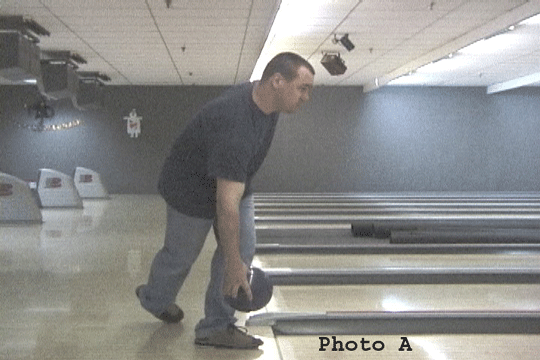
LEARNING NEW RELEASES (part 1)
The last thing a bowler does is release the ball. The old adage “last but not least” certainly applies here. You can do everything absolutely perfect on your journey to the foul line, but if you botch the release, you can turn perfection into disaster.
“Learning New Releases” will be a multi-part series but as I write this, I don’t know yet how many parts. I do know that I want to start very basic and show you how to go about learning new releases as much as the releases themselves. A lot of bowlers understand the motions involved but they don’t know the proper method to learn them.
I will be writing a lot in these articles about muscle memory. Muscle memory (or the lack of it) almost always starts out as our foe, but with a lot of work it slowly becomes our friend. Everyone uses muscle memory every day to perform thousands of tasks with their feet and hands. If you drive a car you don’t have to look down and see where the brake is…your foot just knows where to go. If you have steps in your house, you don’t have to look down to see how high to raise your foot…your foot just seems to know. If you know how to type on a keyboard, you don’t have to look and see where every letter is…your fingers just seem to know where they are.
If someone handed you a new keyboard with the letters switched around, you would have to stop and look each time you made a keystroke. So at first, you would have to go pretty slow until your fingers learned the new key pattern. Then you can go just as fast as before without thinking about it. You will miss a key now and then for a while because your fingers will suddenly jump back to the old key pattern memory they knew before, but in time they will learn. The same holds true in bowling.
As a bowling coach, if I have learned anything at all from teaching people new things, it is that everyone is different. Everyone learns at a different pace. I have learned that I not only have to teach a student’s mind so they can understand the “what” and “why,” I have to train their individual groups of muscles the “how” part of learning. This takes time and effort; shortcuts will be rewarded with poor performance.
Everything I am about to describe will be for a right handed bowler. So lefties need to reverse things to fit their side of the lane.
Learning a new release
The first release I am going to cover is a simple hook release. The simple hook release is the basis for nearly every other release so it is very important that everyone know how to do it. I strongly suggest you save this article so you can refer back to it when you are reading the next article of the series. I will not cover this in such fine detail again.
The first step is to go up to the foul line and get in your “finishing position”. Your “finishing position” is the position you would be in if you just completed a perfect shot. Once you are in your finishing position, just hold the ball straight down beside you like in photo “A”.

Look down and place your fingers directly behind the ball. This is represented in Photo “B” at the “6:00 position”. Then rotate your fingers all the way around to the side of the ball represented by the 3:00 position in photo “B”. Once your fingers have felt those two positions move them back to a position halfway in between. This will be your 45 degree position. Make note that you will not be turning your hand or fingers from 6:00 to 3:00 to perform this first release. In fact we will not be turning the hand at all. The exercise of “feeling” 6 and 3 is just so you can “feel” the middle in between the two. That middle is what we are after and that will be your 45 degree position.
.
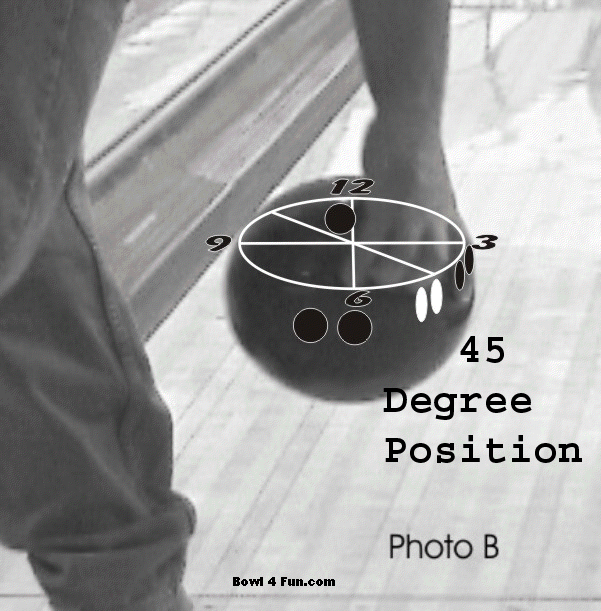
The 45 degree position will be the position you will use most of the time. If the fingers are in this position and directly under the thumb at the point of release, you will produce a 45 degree “axis of rotation”. I will explain “axis of rotation” a little later in this article so don’t get too excited if you don’t know what it means.
Now that we are in our finishing position and holding the ball down by our side with the fingers in the 45 degree position, we are ready to do a little swing and release. Keep your eye on your hand and gently start swinging the ball back and forth. You have to watch your hand because we want to keep it in that 45 degree position with the fingers directly under the thumb. A lot of people’s hands want to turn back behind the ball as the ball travels back. This may not be a problem later, but for now, we want to try and keep our hand steady. Just swing the ball a foot in each direction; we don’t want a big swing at this point.
After a few swings, if you are able to keep your hand in the 45 degree position, simply let go of the ball the next time it passes your leg. Don’t force the ball forward, lift it, or help it in any way. Simply swing and let go. The thumb should come out first which will transfer the ball’s weight to the fingers. Just gently follow through as this happens and you should pick up a few rotations as the ball leaves your hand.
It may seem like we are taking baby steps here and we are. We are teaching little muscles in your hand to remember that 45 degree position and most people’s hands do not learn much faster than a baby. Make sure when you let go of the ball, your fingers are directly below the thumb. This will keep you from “tilting” the ball too much. I will discuss “tilt” a little later along with “axis of rotation”.
If you are strong enough during this exercise, do not allow your wrist to bend back under the weight of the ball. If you are not strong enough to resist the bending of the wrist, then consider using a wrist brace or a lighter ball. If you allow your wrist to bend back, you will loose revs once we put the ball into full motion.
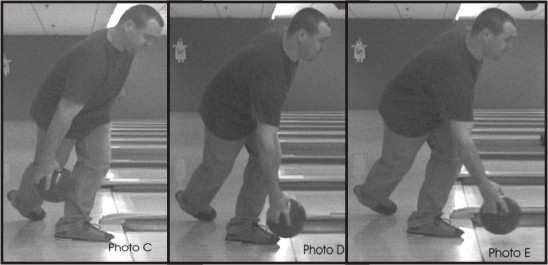
3 photos show only a short swing is needed.
The Ball Roll, Axis of Rotation & Tilt
The ball roll we are after has a “45 degree axis of rotation” and very little “tilt”. I am going to shorten the term “axis of rotation” to “AR”. A little imagination is needed to understand what “AR” means. A ball sitting still has no “AR” at all so it can’t be measured. “AR” is created when we rotate the ball in any direction. If we start rotating a ball, it rotates around an imaginary axis. I like to think of this imaginary axis as an axle. Everyone knows that an axle is…every wheel has one.
I like to compare a bowling ball to a bicycle wheel. A bicycle wheel has a steel axle that it rotates around. This is far from imaginary and it’s easy to see. A bowling ball has no such steel axle so we have to imagine that it’s there once the ball starts rotating.
If I were to take a bicycle wheel out to the lane and hold the axle parallel to the foul line, it would have no axis rotation until I give it a spin… because there is no “rotation”. Ok let’s give it a spin!
Now the wheel has ZERO degrees of axis rotation. Notice the word “degrees”. We measure a bowling ball’s “AR” in “degrees” off the foul line. Our bicycle wheel has its axle parallel to the foul line so it is zero degrees off.
Now let’s turn the wheel 45
degrees to the left and keep it spinning. The wheel now has 45 degrees of axis
rotation. Photo “F” is an illustration of what that wheel would look like
at 45 degrees.
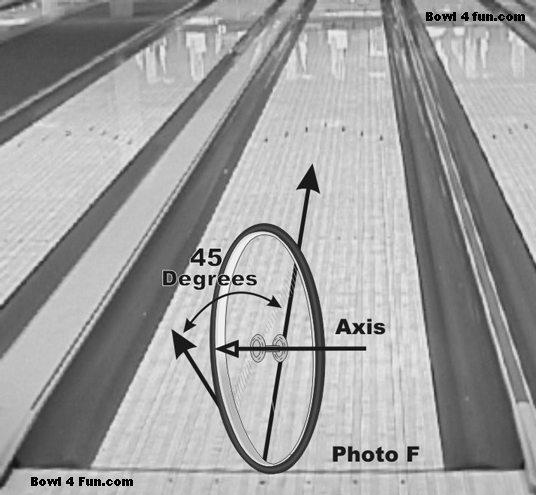
The long arrow pointed down the lane is the wheels direction of travel if it were headed toward the pins. The shorter arrow pointing off to the left at a 45 degree angle shows the direction the wheel is rotating. Obviously if the wheel is spinning at a 45 degree angle to the direction of travel the wheel must be skidding and spinning on the oil. That is exactly what your ball does if you throw a hook ball. It spins and skids in the oil until it gets enough traction with the lane to start turning to the left (hook).
In photo “G” I have added a ball
to the wheel to help you understand it needs to do the same type of rotation as
the wheel. Notice that the ball has a line running through it just like the
bicycle wheel did. I have labeled that line the axis and on the left side of
that line is an arrow head. That arrow head represents your “Positive Axis
Point” or PAP for short. Every good bowler should learn how to pick that spot
out as the ball rolls down the lane. It helps you see your “AR”. It can be
helpful if you place a piece of white tape on your PAP to help you learn to spot
it. Your pro shop can help you find your PAP so you will know where to put the
tape. I suggest once you find the PAP on your ball that you mark it with a punch
so it will always be easy to find. Some ball drillings have weight holes on the
PAP and you can just watch that.
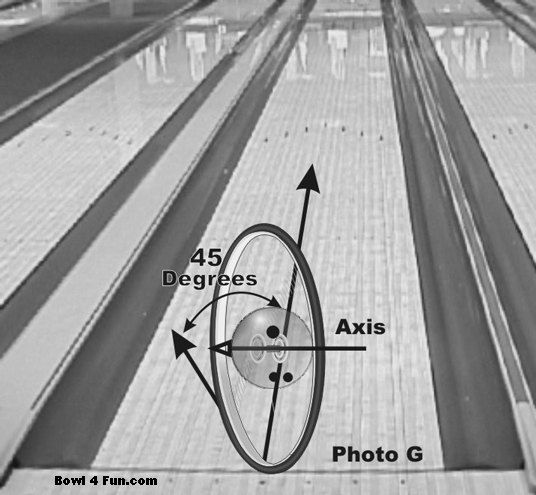
In the next photo (Photo H) you
will see that the wheel and ball are now tilted. The wheel / Ball still has 45
degrees of “AR” but you will notice that the axis is now tilted up on the left
side of the ball and down on the right side. This is called “axis tilt.” In
Photo G you can see that the axis line is fairly level so it has little or no
axis tilt. In most cases we don’t want very much axis tilt. This causes the ball
to spin more like a top and it has a hard time “reading” the lane. Try to learn
to pick out your axis tilt before the ball gets to the arrows.
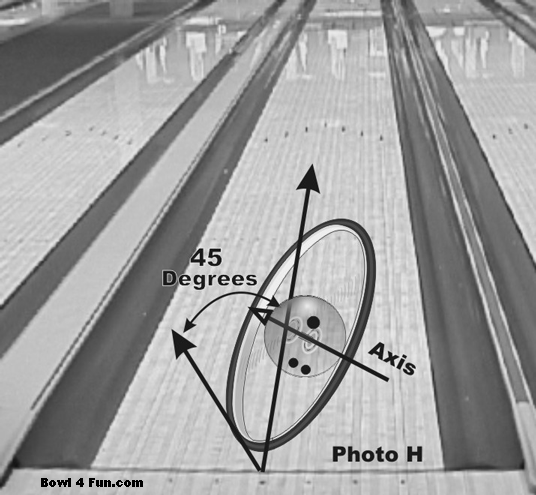
If you are not too good a “seeing” your axis tilt you can cheat a little by looking at your ball when it returns from a shot. If there is enough oil on t he lane the ball will have oil lines to the left of the thumb hole. An acceptable amount of axis tilt will place the first oil line 2 inches from the thumb hole or less. Too much axis tilt will place that first oil line more than two inches left of the thumb. Left handed bowlers need to reverse this and look for their oil line on the right side of the thumb hole.
Unfortunately you can’t look at the oil lines and see your “AR”. The only way to see that is to watch the ball roll down the lane. It is important that you learn to see your ball’s “AR” and tilt because it is the only way you can know if you did the release right.
Oh yeah, we were learning a release weren’t we? I felt it was important to give you an idea of what the ball roll should look like if you did the release properly. Remember at this point we are only doing a short swing and release. The ball should leave your hand with a 45 degree axis rotation and very little tilt. The speed of the ball should be very slow because we are not helping the ball at all. Do this little exercise enough times that you do it right every time with ease. Remember we are teaching your hand what it feels like to do it properly and it has a slow memory.
Once you can do the little short swing and release then move on to a bigger swing. You are still in your finishing position holding the ball down by your side with your hand in the 45 degree position. Just push the ball out a little harder and let it swing back more and release. Make sure that your hand keeps its position and the ball roll does not change.
The next step is to hold the ball about waist high and let the swing and release take place from there.
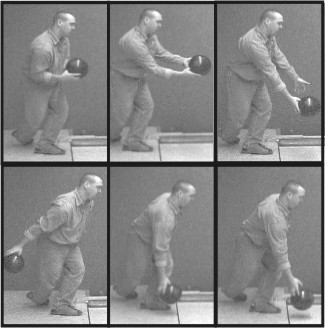
The key here is to keep everything slow. If you get up to full speed too soon your hand will revert back to its old muscle memory and you will never get the release right. Remember this is just a very simple hook release and I will go into more complex releases in future articles. I know a lot of you are foaming at the mouth wanting to learn to REV IT I will get to that later. Even if you know how to perform a simple hook release still go through this exercise. This exercise is the basis for learning all the releases.
You can organize a Ron Clifton 2 or 3 day Clinic for your town. Click here for more details.
My email address is
rclifton@triad.rr.com
Stop in the bowl4fun.com chat room and say hi. Ron Clifton is in
there most nights from 11PM to Midnight Eastern Time